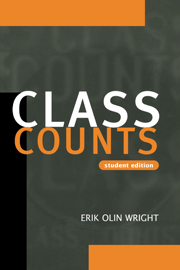Book contents
- Frontmatter
- Contents
- Preface to student edition
- Preface to original edition
- Acknowledgments
- 1 Class analysis
- Part I Structural analyses of classes
- 2 Class structure
- 3 The transformation of the American class structure, 1960–1990
- 4 The fall and rise of the American petty bourgeoisie
- 5 The permeability of class boundaries
- Part II Class and gender
- Part III Class structure and class consciousness
- Part IV Conclusion
- References
- Index
- Index of subjects
2 - Class structure
Published online by Cambridge University Press: 22 September 2009
- Frontmatter
- Contents
- Preface to student edition
- Preface to original edition
- Acknowledgments
- 1 Class analysis
- Part I Structural analyses of classes
- 2 Class structure
- 3 The transformation of the American class structure, 1960–1990
- 4 The fall and rise of the American petty bourgeoisie
- 5 The permeability of class boundaries
- Part II Class and gender
- Part III Class structure and class consciousness
- Part IV Conclusion
- References
- Index
- Index of subjects
Summary
The starting-point for class analysis is the problem of class structure. The investigation of class structure provides us with the way both of situating the lives of individuals for micro-class analysis and of describing variations in societies across time and place for macro-class analysis. In the previous chapter we explored the theoretical foundations for this concept. In this chapter we will descriptively map out the broad contours of the class structure in several developed capitalist countries and examine how it has changed over time in the United States.
In practical terms, this task involves pigeon-holing people into specific categories on the basis of responses they give to a questionnaire about their work. It is not possible to directly observe a “class structure” as such. What one observes are individuals who occupy specific places in a social structure. By asking them appropriate questions and aggregating their responses, we generate descriptions of the class structure as a whole. To some readers this may seem like a fairly sterile scholastic exercise. Taxonomy, classification, pigeon-holing – these are surely the tedious preoccupations of narrow academic specialists. What is worse, squeezing individuals into simple categories seems to obliterate the richness and complexity of their lives. Class becomes a static set of simple boxes rather than a complex, dynamic process. Would not it be better to pursue qualitative field research with relatively loose and flexible concepts capable of adapting to the complexity of the situation?
- Type
- Chapter
- Information
- Class Counts , pp. 43 - 55Publisher: Cambridge University PressPrint publication year: 2000



